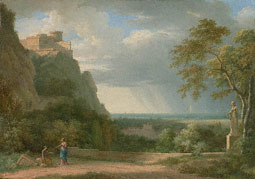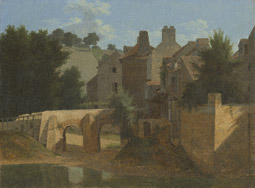|
This exhibition focuses on the practice of painting sur le motif—in nature—as it developed in Europe during the late 1700s and early 1800s.
In the decades around 1800, a golden age of painting en plein air (outdoors) emerged in Italy. Artists from France, Germany, Great Britain, and Scandinavia came south to work in the Italian landscape, where the effects of changing light and weather were ideal for experimenting in oil sketches—small, rapidly executed paintings usually made as preparatory studies for more ambitious compositions completed in the studio. Soon the oil sketch came to be considered an autonomous work of art in its own right. In 1816 the French Academy established the Prix de Rome du paysage historique (Rome Prize for Historic Landscape) specifically for landscape, officially signifying the new prestige of landscape painting.
|
 |
|
The writing and practice of Pierre-Henri de Valenciennes, the leading landscapist of the late 1700s and early 1800s, played a key role in elevating the status of landscape painting. This composition is characteristic of Valenciennes's classical style: figures in ancient costumes are placed in a landscape inspired by the surroundings of Rome, with ancient sculpture and monuments under a stormy sky.
In his influential treatise published in 1800, Practical Elements for Perspective Painting for Artists' Use (a copy of which is on view in the exhibition), Valenciennes argued that landscape painting appeals to the same humanistic and moral values as history painting, long considered the most prestigious form of painting. He also encouraged young landscapists to work in nature, using the oil sketch to rapidly capture changing conditions of atmosphere and weather. Valenciennes's treatise remained an essential reference for painters throughout the 1800s.
|
 |
 |
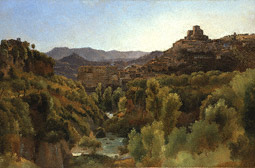
 |
 |
View of Subiaco, Jean-Joseph-Xavier Bidauld, about 1818. Private collection
|
 |
Around 1800, artists from throughout Europe converged in Italy and spread across the countryside, painting outdoors. The Italian landscape became an artistic laboratory for studying the effects of light and changing atmosphere in oil sketches.
Jean-Joseph-Xavier Bidauld created this view of the small hill town of Subiaco, near Rome, during an extended trip to Italy. The painting is precisely executed, with an enamel-like surface and a cool, luminous atmosphere. Bidauld exquisitely rendered the sunlight of a warm Italian afternoon, adding depth to the colors of nature.
|
 |
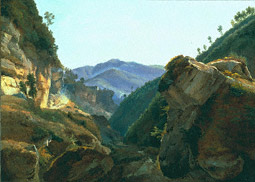
 |
 |
Mountain Landscape with the Road to Naples, Jean-Charles-Joseph Rémond, about 1820. The J. Paul Getty Museum. Promised gift of Fern and George Wachter in honor of Scott Schaefer
|
 |
 |
After visiting Rome, many landscape artists traveled farther south to paint the landscape near Naples, including the small town of Sorrento overlooking the Adriatic Sea and the dramatic coastal views of the Gulf of Naples.
Jean-Charles-Joseph Rémond won the Prix de Rome du paysage historique (Rome Prize for Historic Landscape) in 1821, which allowed him to study at the French Academy in Rome. He frequently took field trips as far as Naples and Sicily, painting numerous oil sketches of the Italian countryside.
The warm, vibrant atmosphere of this landscape near Naples is rendered with brilliant blue, fresh green, and golden tones.
|
 |
 |
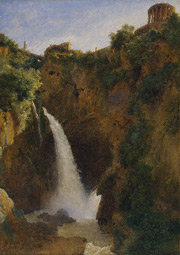
 |
 |
The Falls at Tivoli, Louise-Joséphine Sarazin de Belmont, 1826. Fine Arts Museums of San Francisco
|
 |
Inspired by Pierre-Henri de Valenciennes, painters attempted to capture the
most fleeting of natural phenomena—light, wind, and weather conditions—in small oil
sketches executed rapidly on the spot.
One of only a few women artists in Europe in the early 1800s, Sarazin de Belmont was a pupil of Valenciennes. She followed his recommendation to practice painting the effects of light on running water, seen here at the falls at Tivoli. With a light brush and quick stroke, she captured the rushing water and the reflecting sunlight.
Tivoli, an ancient city in the Sabine Mountains popular with Roman emperors, boasted waterfalls, grottoes, ravines, and Roman temples and villas that were a popular motif for landscapists beginning in the 1600s.
|
 |
|
Artists continued the practice of working outside when they returned from Italy to their home countries. Many French painters worked in the countryside surrounding Paris and in the south of France, painting picturesque villages, vegetation and rock formations, ancient ruins, and coast views.
Jean-Victor Bertin, Pierre-Henri de Valenciennes's leading pupil, established an important studio in Paris and trained several of the winners of the Prix de Rome du paysage historique (Rome Prize for Historic Landscape), including Jean-Charles-Joseph Rémond.
Bertin carefully composed his landscapes in the workshop based on his observations of nature and often depicted historical or mythological scenes. He also made several topographic views of sites in the Île de France, the region around Paris. In this view, he focused on articulating how the light transforms the architectural forms into almost geometric masses.
|
 |
|
Jean-Baptiste-Camille Corot combined the principles of classical landscape with a more personal approach to nature and a poetic sense of color and light. Trained by Jean-Victor Bertin, Corot spent years traveling and painting outdoors in Italy. After his return to France, he continued painting outdoors and worked frequently in the Île-de-France.
In the summer of 1830, Corot visited northern and central France, painting the countryside. In this painting he focused on the strong geometric forms of a village near Orléans. Corot rendered this scene on the spot and may have kept it as a reference for light effects in other works painted in his studio.
Corot had a profound influence on the next generation of French landscape painters, who would become known as the Impressionists.
|
 |

